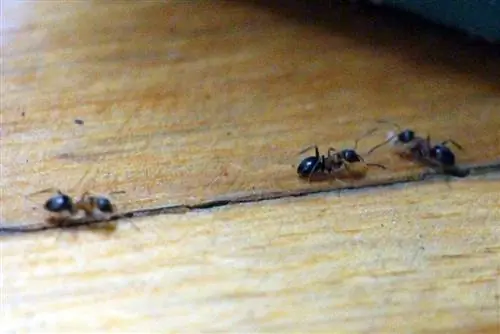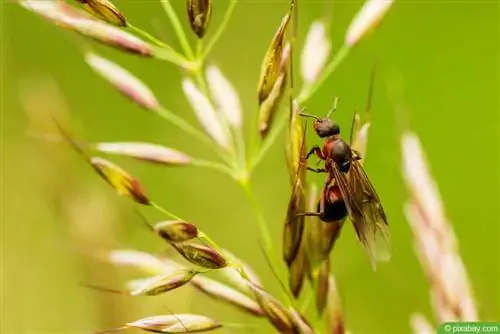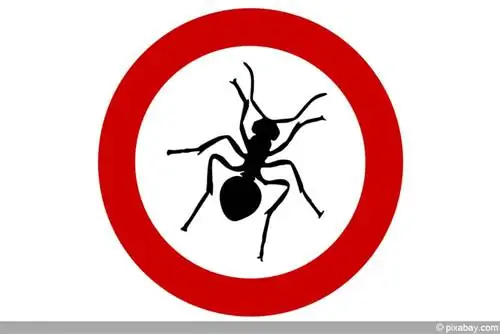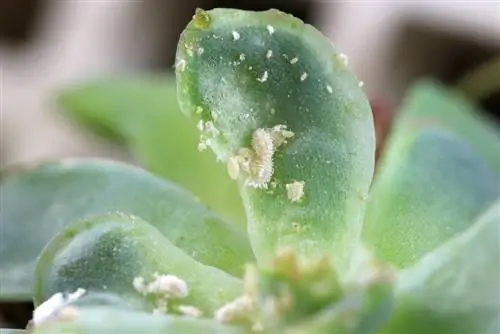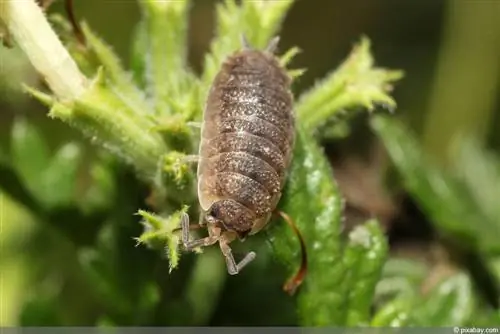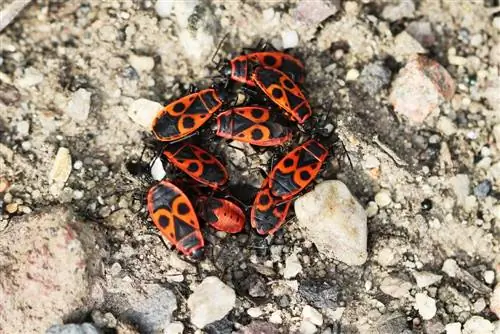- Author admin [email protected].
- Public 2023-12-17 03:39.
- Last modified 2025-06-01 06:48.
You can fight annoying ants in the garden, but if possible, you should not kill them. Actually nothing new, just normal gardening since it was “invented”, which is why there is no shortage of tried and tested home remedies and methods:
Determine ants before combating
Theoretically, there can be 100 different species of ants running around in your garden, many of which present randomly selected “ant articles”. Certainly interesting, especially for ant researchers, but: In the garden you usually only deal with two species of ants, whose appearance and lifestyle are quickly described:
Ant (garden ant, lawn ant) “Lasius niger”
- most common ant in the garden
- matt black, 0.5 cm long, body with three segments
- Head with compound eyes (including hundreds of individual eyes that created images of individual pixels 100 million years before computer screens)
- complicated multi-part middle section
- thick rear end (with internal organs, poison storage, for queens eggs for the next ant colony)
- build nests in the ground (for stability, preferably around plant stems, for a good living climate, preferably under sun-warmed slabs, boards, stones)
Yellow garden ant “Lasius flavus”
- bit smaller than the black version
- yellowish to reddish
- otherwise “composed” similarly to the black colleagues
- prefers the damp part of the garden
- builds (dome) nests (in sandy, sunny places, under stones/slabs, in tree bark, lawn, cracks in walls)
If a thriving ant population has declared exactly the place in your garden to be an ant territory where ants cause maximum nuisance, you usually don't need to know which species is causing the nuisance. If an agent can control ants there, it can control red, black, green, and pink-and-blue striped ants; If a remedy is no good or is more likely to poison people/animals/plants than ants, it doesn't matter whether it doesn't work against ancient German ants or Indonesian tiger ants. Dealing with most of the 100 “garden ants” is unproblematic and is shown below, first of all the rare exceptions:
Ants with unusual behavior, in an unfamiliar place
In rare individual cases, the type of ant is important:
- “Normal-looking” but unusually stubborn ants could be (rarely) invasive, super-colony building Lasius neglectus
- “Normal-looking ants” colonize wooden parts of garden buildings, these could be “wood-eating” brown carpenter ants “Lasius brunneus” or shiny black carpenter ants “Lasius fuliginosus”
- There are clearly abnormal-looking ants moving in the garden
- No reasons to become an ant researcher, but rather to seek information and support, e.g. B. at the local environmental office or at www.ameisenschutzwarte.de
Tip:
Fears of being bothered by biting exotic ants in the garden are rather unnecessary. Monster ants introduced from southern countries do not survive our winters, and no monster ants are introduced from northern countries (because there are only small ants there, like here). If you see a large or otherwise strange ant in your garden, you should find out which neighbor keeps ants as a hobby and is a customer of an unscrupulous ant dealer (even L. neglectus, which can form colonies with over 100 million ants, has already been found). described as “suitable for beginners”); This neighbor is responsible as a disturber and is allowed to collect or remove his ants himself.
“Fighting ants” as a problem that doesn’t really exist
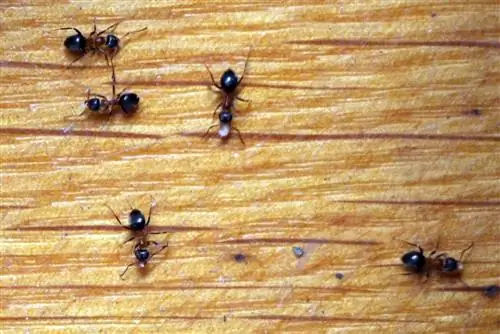
Don't worry, we don't want to tell you that you have to live with ants that are currently hollowing out your terrace from below. It's just that getting rid of errant ants isn't the problem that seems to arise at first glance on the web. If sales-motivated sources of information and forum literature influenced by them are left out, a real picture of human-ant coexistence is formed: a largely conflict-free co-existence that occasionally requires delicate corrections and very rarely decisive interventions.
In reality, most German gardeners never have the need to fight ants; The “professionals” among these gardeners who care for the garden soil would have absolutely no idea why they should do that (on the contrary, ants produce humus). Reducing escalating ant populations to normal levels through human intervention - no problem, driving ants away from places where they disturb people - also no problem; For experienced gardeners, both are a normal part of gardening and gardening and are certainly not difficult.
You can call it “fighting ants” (and see it as a welcome opportunity to free yourself from the aggression that arose from American presidents and other crude phenomena of the times), you can call it “ensnaring ants” (and get over it the correct moon phase for relocating ants) - you will undoubtedly get along well with the ants if you know what to do, when, where and why.
More important than individual home remedy tips without justification is therefore a look at which means and substances you can use to influence which “ant phenomena” and with what chances of success. Including justification, so that you can assess every old fairy tale and every new fake product against ants in the future:
Solitary wandering ants
If individual ants wandering around the garden are a problem, the advice seems to be to seek relief from your ant phobia with a psychiatrist. Since ant phobias are rare, perhaps a very special young plant has just been planted, or the garden is not in very good condition, which often causes problems with rampant ant populations (for long-term remedies, see “Garden in Balance”).
All reason enough to carefully observe individual ants that could be planning the following: There is a nest nearby from which workers start looking for food/water. You could now kill each of these exploring ants (you can do this by stepping on them without any home remedies), but be sure that the next explorers will follow as long as food continues to tempt. If the freshly planted young plant is the “object of desire”, it gets a scent defense fence; If you generally want to prevent an ant trail from forming in a certain part of the garden, there is only one practical tip:
- Remove ant treats such as open food + pet food
- Attracting scout ants to another part of the garden
- Transplant area to be protected with anti-ant scents
If the wandering ant is unusually large and "drags" an unusually thick abdomen, you have a queen who is in the process of founding a new ant colony. Shortly before, she swarmed out, mated (in flight, sometimes a variant), shed her wings and is now looking for a nice place for a nest. If you have the heart to deprive the hopeful young queen of her life and her people, kick her hard or kill her with a newspaper. If not, you can gently sweep them onto a dustpan and dump them in a place that won't disturb their nest, such as a bed. E.g. at the back of the garden by the old trees.
ant streets
If the ant is not wandering around, but is marching straight in one direction with lots of buddies, you can redirect this ant trail by finding the food-providing target and moving it to where the ant trail doesn't interfere. You can then only seal off the many small, tempting targets nearby with scented plants etc.; If you are really serious, you should also send the ants in another direction with enticing offers.
Ant Nest
Or you can follow the ant trail to the other end, to the nest. If this does not disturb the given location, the ant route is redirected; if it causes disruption, the nest could be relocated. This works with the flower pot trick, but only if a few requirements are met:
- Ant nests are in the lawn or garden
- It's about "our favorite two ant species" Lasius niger or Lasius flavus
- Mound of earth was freshly piled up after rain followed by sunshine
- Then immobile breeding stages should be rescued from the wet cold
- An overturned flowerpot becomes warmer in the sun than the anthill and is therefore often used as a nesting aid
- Fill the flower pot with wood shavings or crumpled newspaper (loosely)
- Place on the nest you have started and wait 2 to 3 days
- Push the cardboard, spade, dustpan under the flower pot, lift it and move it to the appropriate place
- Surrounded with good food if the new home is close to the old one
- The ants would run back 10-20 meters to their original place of residence, which was ultimately chosen for specific reasons
- If there are implementation difficulties, www.ameisenschutzwarte.de, working group for emergency and rescue resettlements, can help again.
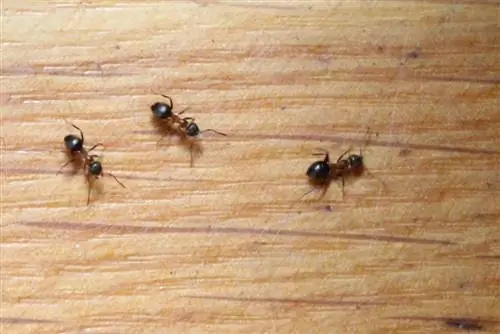
If nests (small piles of fine soil) in your ornamental lawn bother you, they shouldn't actually bother you because ants, like earthworms, belong in the lawn and are necessary if you don't want to end up with artificial turf at some point. If the piles get out of hand, “Garden in Balance” explains how to stop it. Until then, only brutal means can help: When the sun shines again after rain, queens often warm themselves up in the hill. A strong jump with sturdy shoes puts an end to sunbathing and life and the correct height adjustment on the lawnmower cuts off “a bit of a nest” until the ants move indignantly.
Proven home remedies and methods for controlling ants
After this excursion into the world of ants, you will know enough to put together an arsenal of tools with which you can influence “your ants”.
Ants can smell very well, you can take advantage of that. On the one hand, the normal garden ant is constantly hungry because it not only feeds itself, but also “nest mates”. As a true sweet tooth, she cannot resist any sugary substance; A simple (conveniently inverted) plate of sugar water is sufficient as an attractant (in an environment without water sources, a bowl full of water can be the best attractant because ants also suffer from thirst).
On the other hand, your very fine sense of smell classifies quite a few smells as repulsive, here is a list for a quick check, there are definitely some “ant horrors” in your household:
- Basil, also against cabbage white butterflies and snails
- Mugwort
- Stinging Nettle
- Chili
- Eberraute
- Oak bark
- Vinegar (evaporates quickly and may only be used in small quantities in the garden)
- Fernwort
- Lamb lettuce
- Grapefruit
- elderberry
- Coffee grounds
- Camphor
- Nasturtiums, also against cabbage white butterflies and snails
- Chervil
- Herbal manure
- Lavender
- Marjoram
- Cloves (spice)
- Oranges
- Peppermint
- Rainsy, also against cabbage white butterflies and snails
- Rosemary
- Sage
- Sweet clover (this is what is meant when the use of “melilot clover” is recommended)
- Milfoil
- Tea tree oil
- Thyme, also against cabbage white butterflies and snails
- Thuja
- Tomatoes
- Juniper
- Rue
- Wormwood
- Urusalflower
- Cinnamon
- Lemon
You can use scents to drive away ants or interrupt an ant trail, for example. B. Vinegar confuses the sense of direction. All anti-ant aromas can be used in a variety of ways: as plants, freshly cut leaves, peels, oils, manure (using leftovers for many things, including lemon peels, for example) and in many strategically convenient places: directly in nests stick, spray/sprinkle in the path, tie fresh shoots around tree trunks, etc.

Such influences on ants have been part of gardening for centuries; The simple and cost-effective means and methods with which you can control ants in every situation have been used for just as long. We don't expect you to give any tips on how to lay out cress or spray lavender oil into the path of ants or pour coffee grounds (which also fertilize your plants) into the path; You will certainly be able to develop your own ideas using existing resources. The more creative you are, the more fun it is to get rid of ants: Depending on where ants appear and in what form, there are one or more ingeniously suitable means to “make them change their minds” in exactly this place.
You're not finished with the list above; Ants in pots or other demarcated areas can be displaced by repeated flooding (or actively set to “pot relocation”); prevent climbing trees (balcony boxes etc.) glue rings, pebbles (drainage in pots/buckets, terrace construction) are not colonized by ants. If the ants are invading the building structure under the terrace, perhaps a simple plate of sugar water can persuade them to turn back. If you've been living there for a while, it's worth trying a powerful construction vacuum cleaner before dismantling the patio and calling the pest controller.
If you have some fun with it, you'll probably come up with even more ingenious solutions - like the suggestion to place plastic table legs in small water containers, because the ants definitely don't sail these "seas" (and if they do, you don't care about the ant infestation because you make a lot of money online with films of ants in small sailing boats).
Garden in balance
Typical forum complaint from a new gardener who hasn't yet understood that he is putting himself in the devil's kitchen in terms of costs, work and he alth if he runs his garden with salesman's advice instead of knowledge: “I've almost tried everything; from baking powder to insecticides for sprinkling and casting agents from various manufacturers; Bait cans and scarifying, flooding and more fertilizer, weed killer, soil replacement with new lawn seeding - nothing helped even remotely, after a few days new brood hatched"
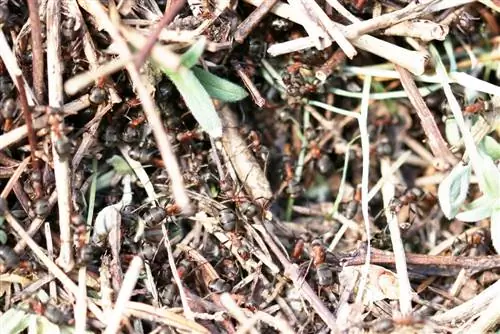
Short answer from Prof. Dr., who works in biological research and makes his knowledge available for free to advise such people (to save us + ants from such people): “If you create such ecological chaos in You can't really expect anything other than what you say if you do anything to your garden. It's no news to me that none of this is of any use. With the baking powder you have fallen for a fairy tale that can no longer be eradicated." Later he explained everything in detail, which was answered by the new gardener by passing on the unspeakable baking soda tip to the next forum member (baking soda may kill ants, but it is about as effective as a control agent as a glass of water in which you put ants individually drown).
One thing is certain: the more nature there is in the garden and the more this nature is in balance, the less likely ant conflicts orThe more likely it is that ants will settle in inappropriate places, but these ants will not be noticed at all. Because in the natural garden, some species become aware of the ants in front of you and ensure that the population remains at normal levels: Natural enemies of the ants include: B. many birds, foxes and badgers, shrews, frogs, toads and other small reptiles/amphibians, predatory insects and spiders (99% of young queens are “eaten away” in a he althy environment).
If the garden ecology isn't right, you can redirect ants; but you can save yourself from interventions like “remove ant-feeding aphids” and “add ant-brood-eating nematodes” from the start. People can work towards achieving ecological balance through correct gardening; but it is not possible for the hobby gardener to create an artificial balance in the garden. Incidentally, this also applies to the entire area of “poison against ants”, the use of which against the beneficial ant, which fulfills important functions in the natural environment but is now generally prohibited in gardens.

